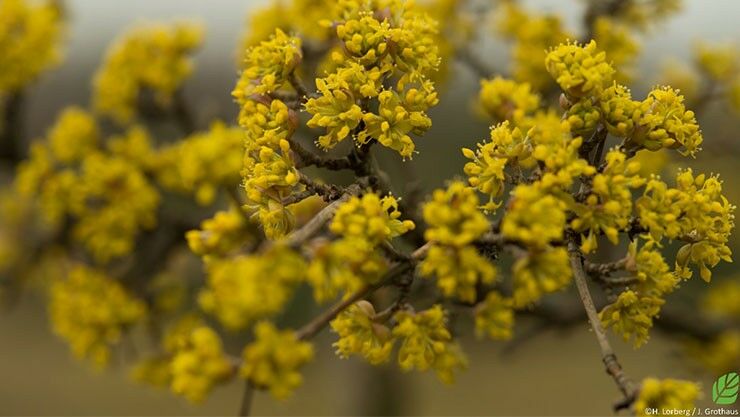

Specific epithet comes from the Latin word for male in reference to the absence of fruits that sometimes occurs for several years after new plants begin to bloom. Cornus is also the Latin name for cornelian cherry. Genus name comes from the Latin word cornu meaning horn in probable reference to the strength and density of the wood. Common dogwood, Cornelian cherry, Male dogwood, Cornejo macho, Sorbet, Cornelian Cherry Dogwood, dogwood, European cornel and Cornel cherry are some of the popular common names of the plant. In Asia, it is found growing in Azerbaijan, Armenia, Iran, Israel, Georgia, Syria, Lebanon and Turkey. The plant is native to south western regions of Asia and southern Europe.

Apart from the cornelian cherry, the most popular include: alternate-leaved dogwood, flowering dogwood, kousa dogwood, wedding cake tree and Japanese cornelian cherry. There are nearly 50 species of cornelian cherry in the world. The modern woodland appears to be ancient but it has been transformed by men and main areas even have been used for tillage.Cornus mas, the Cornelian cherry or Cornelian cherry dogwood, is a species of flowering plant in the dogwood family Cornaceae. Nevertheless these species are present throughout the record indicating a survival in the Riesewohld area. In the course of time a change in woodland composition is recorded which is characterised by an increase of beech and hornbeam and a decrease of hazel, lime and elm. Human influence culminated in the Iron Age at the same time as the enclosure was built. Human indicators show strong influence of people at least from the Late Bronze Age onwards. At the beginning of peat formation the woodland is mainly built up by lime, oak, elm, maple, hazel, birch and pine. According to the age-depth-model peat growth started some 4,000 years ago. A comparison of the archaeological features with the pollen record of a small moor spring complements the record. Medieval ridge and furrow systems (Wölbäcker) are recorded as well and place names give hints for land use in modern and historical times. Based on morphological examination these also date to the Iron Age. Strong evidence is given by an Iron Age enclosure and some field systems detected by analyses of Laser-scan-data. From the Bronze Age onwards graves and stray finds indicate the settling of the area.

Single mesolithic and neolithic finds attest the presence of people even when there are no proofs of settlements. The archaeological survey in the forested area of the Riesewohld in Schleswig-Holstein, Northern Germany, revealed a diverse picture of settlement and arable activities. The composition of the assemblages from different sites points to the general continuity in exploitation of similar array of wild plants across the research area and through the period considered (7500–5500 cal BC)." The anthracological record suggests that the Mesolithic and Early Neolithic population had access to and made use of open woodland (wooded steppe), oak forests, and riparian vegetation. fruit stone (hard endocarp) and nutshell (hard pericarp) – indicates that the main collected taxa were Cornelian cherry (Cornus mas), hazel (Corylus avellana) and elder (Sambucus sp.). The macro-botanical evidence, comprising mainly plant parts more likely to be preserved – i.

The taxa represented in the macro-botanical assemblages are interpreted in terms of land use and exploitation of wild plant resources, and are considered as an indirect evidence of the vegetation around the sites. "The archaeobotanical datasets (seed/fruit and wood charcoal) from one Mesolithic and several Early Neolithic sites in south-east Europe, located in the Mid-Lower Danube catchment, are presented and discussed in relation to the available archaeobotanical and palaeoenvironmental data from the region.


 0 kommentar(er)
0 kommentar(er)
